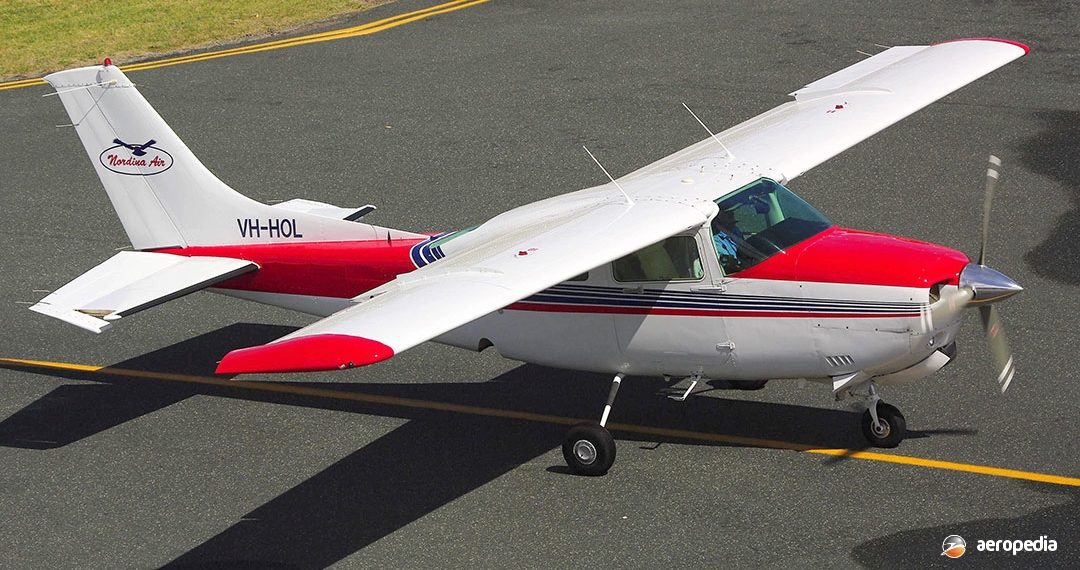Photograph:
Cessna 210N Centurion VH-HOL (c/n 210-64475) at Jandakot, WA in October 2012 (David C Eyre)
Country of origin:
United States of America
Description:
Light cabin monoplane
Power Plant:
One 213 kw (285 hp) Continental TSIO-520-C six-cylinder horizontally-opposed air-cooled engine
Specifications:
- Wingspan: 11.2 m (36 ft 9 in)
- Length: 8.6 m (28 ft 3 in)
- Height: 2.93 m (9 ft 7½ in)
- Wing area: 16.35 m² (176 sq ft)
- Max speed at 5,791 m (19,000 ft): 377 km/h (234 mph)
- Cruising speed at 75% power at 3,048 m (10,000 ft): 317 km/h (197 mph)
- Cruising speed at 7,315 m (24,000 ft): 359 km/h (223 mph)
- Initial rate of climb: 340 m/min (1,115 ft/min)
- Service ceiling: 9,205 m (30,200 ft)
- Range with no reserves at 7,315 m (24,000 ft) at 359 km/h (223 mph): 1,915 km (1,190 miles)
- Range at 3,048 m (10,000 ft): 1,714 km (1,065 miles)
- Empty weight: 930 kg (2,050 lb)
- Loaded weight: 1,542 kg (3,400 lb)
History:
The Cessna Model 210 was introduced to the Cessna range in 1959 as an intermediate model between the 182 and the twin-engine 310, to fill a need for a high-performance, single-engine aircraft. The prototype was flown for the first time in January 1957 and subsequently the type was produced in a variety of variants and, when production ceased in 1985, some 9,240 examples had been completed. However, with the re-introduction of production of a number of Cessna models in the late 1990s following the solving of some of the problems in the United States with regard to product liability, the Company indicated it may place the Model 210 back into production.
For many years the Model 210 was built in two basic models, the 210 with a normally aspirated engine, and the T210 with a turbocharged engine. The first main change in the design occurred in 1967, when the model released in that year (the appellations to the type number had reached 210G and T210G) had a re-designed cantilever wing and enlarged tail surfaces. It is noteworthy that a Turbo Centurion held the world altitude record for its class of 12,906.5 m (42,344 ft) for a period.
In 1977 a new model of the 210 series appeared. Known as the Pressurised Centurion, it featured optional wing-mounted weather radar and anti-icing and de-icing systems. Fitted with a Continental TSIO-520-P engine of 231 kw (310 hp), this model was able to cruise at 362 km/h (225 mph) with a load of 758 kg (1,670 lb) at 7,010 m (23,000 ft).
In 1984 Cessna introduced a new range of Centurions featuring a new tailplane design of increased span and higher aspect ratio for greater pitch stability, elevator authority, and reduced trim changes, as well as re-styled wingtips, optional 57 litre (12.5 Imp gal) fuel tanks in the outer wings, new engine cowling, nosewheel undercarriage doors, etc. This became known as Model 210R.
Two basic models were then available, the Model 210R with the 224 kw (300 hp) Teledyne Continental IO-520-L engine, and the Turbo Centurion with the 242 kw (325 hp) Teledyne Continental TSIO-520-CE turbocharged engine.
More than 270 examples of the 210 series have been registered in Australia, and a number of examples have also appeared on the New Zealand register.
In the United States Vitatoe Aviation of Chillicothe, Ohio, developed a conversion of the 210 Centurion, this model, being known as the TT-550 Centurion being fitted with a Continental IO-550P turbocharged engine with dual intercoolers and a larger alternator. O and N Aircraft of Factoryville, Pennsylvania converted examples of the Models T210 and P210N to Rolls Royce 250 turbine power.

